IB Physics/Electromagnetic waves
< IB PhysicsG.1 The nature of EM waves and light sources
G.1.1 Outline the nature of electromagnetic (EM) waves
Light is an EM wave. The speed of light is independent of the velocity of the source of the light.
Electromagnetic waves consist of oscillating magnetic and electric fields that are at 90 degrees to each other and in phase. This can be visualised as two transverse waves perpendicular to each other, propagating in the same direction.
G.1.2 Describe the different regions of the electromagnetic spectrum
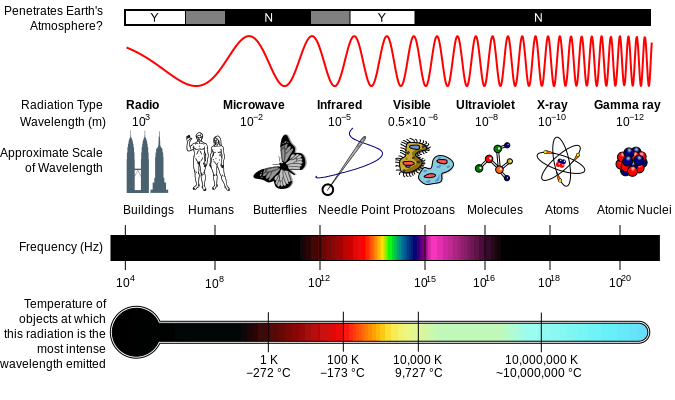
Most importantly is visible light from roughly 400-700 nanometres
G.1.3 Describe what is meant by the dispersion of EM waves
The splitting of white light into its component colours when it passes from one medium to the other because different media have different refractive indices is called dispersion (as shown below).
Red has the greatest wavelength therefore it has the lowest frequency, in comparison to blue light which has a short wavelength and a high frequency.
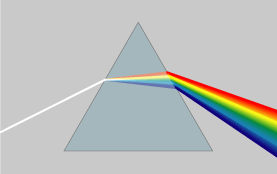
G.1.4 Describe the dispersion of EM waves in terms of the dependence of refractive index on wavelength
In the example above, red is diffracted the least, while violet the most. This is because the waves of lower frequency (i.e. red) are diffracted less (have a lower refractive index).
Dispersion can occur throughout the EM spectrum not just for light.
G.1.5 Distinguish between transmission, absorption and scattering of radiation
Consider an EM wave going through a medium:
----------|medium|--------->
By common sense:
- the wave is transmitted if it goes straight through
- the wave is absorbed if the substances in the medium (e.g. molecules in air) absorb its energy. This energy can be re-emitted.
- the wave is scattered if it bounces of particles in the medium into random directions.
Waves can be partially transmitted/absorbed/scattered.
G.1.6 Discuss examples of the transmission, absorption and scattering of EM radiation
The most common example is; Why is the sky blue and sunsets red?
- During the day: blue light is scattered by small dust particles in the atmosphere. If there was no atmosphere, the sky would be black.
- During sunsets: the light must travel through more atmosphere. Blue light is scattered more than red light (because it has a shorter wavelength) so the blue light is scattered too much before it reaches you, therefore we only see the red light.
Other examples include; UV light being absorbed by the ozone layer and infra-red radiation being absorbed by greenhouse gases (causing global warming).
Lasers
G.1.7 Explain the terms monochromatic and coherent
Monochromatic (mono=one, chromatic=colour) light is of a small range of wavelengths, for example from 500-501 nm. Light bulbs are NOT monochromatic as white light is a mixture of many different frequencies.
Coherent light means the waves are linked together, that is all the photons emitted are in phase with one another.
G.1.8 Identify laser light as a source of coherent light
"Laser light is a source of coherent light".
G.1.9 Outline the mechanism for the production of laser light
Laser stands for "Light Amplification by Stimulated Emission of Radiation".
Stimulated emission, refers to a process where 'electrons that are in an excited state' emit photons and drop to a lower state. This is caused by another photon passing by the excited electron (giving a total of two photons). By nature, both photons are of the same wavelength and are in phase (explanation is not required).
Lasers work by pumping lots of energy into the laser such that over 50% of the electrons in a medium are in an excited state. It then has two mirrors, one of which lets 1% of photons through (this is the light we see).
Search for an animation on the internet to explain this properly.
G.1.10 Outline an application of the use of a laser
Choose one of the following:
- medical applications (laser surgery)
- communications
- technology (bar-code scanners, laser disks)
- industry (surveying, welding and machining metals, drilling tiny holes in metals)
- production of CDs
- reading and writing CDs, DVDs, etc.
G2 Optical Instruments
G.2.1 Define the terms principal axis, focal point, focal length and linear magnification as applied to a converging (convex) lens
Principal Axis: is a straight line that goes through the centre of the lens at right angles to lens surface.
Focal Point: the point on the principal axis through which a ray parallel to the principal axis passes through after refraction in the lens.
Focal Length: The distance of the focal point of a lens from the centre of the lens
Linear Magnification (m):is the ratio between the size (height) of the image (hi) and the size (height)of the object (ho). It has no units.
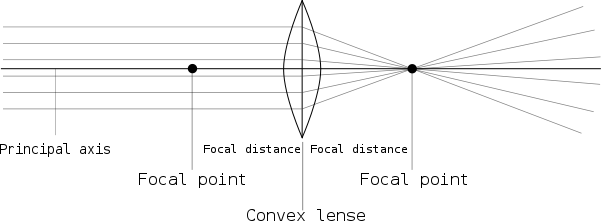
G.2.2 Define the power of a convex lens and the dioptre
The power of a lens is a measure of how much light is bent by it. The power of the lens (P) is defined in terms of the focal length of the lens (f):
The unit for the power of a lens is m -1 or dioptres (dpt)
G.2.3 Define linear magnification
Linear magnification (m) is defined as the ratio of the height of the image hi to the height of the object ho:
G.2.5 Distinguish between a real image and a virtual image
A real image is formed when light rays actually coverge (come together) in a point. Can be projected.
A virtual image is formed by light rays which appear to converge from a point. Cannot be projected on a screen.
The simple magnifying glass
G.2.8 Define the terms far point and near point for the unaided eye
For the normal eye, the far point may be assumed to be at infinity and the near point is conventionally taken as being a point 25 cm from the eye.
Near point - Distance between the eye and the nearest object that can be brought comfortably into focus. “least distance of distinct vision”
Far point Distance between the eye and the furthest object that can be brought into focus.
G.2.9 Define angular magnification
Angular magnification is the ratio between the angle subtended when looking at an object through a lens, and the angle subtended when looking at the object using the naked eye.
The compound microscope and astronomical telescope
G.2.12 Construct a ray diagram for an astronomical telescope with the final image at infinity (normal adjustment)
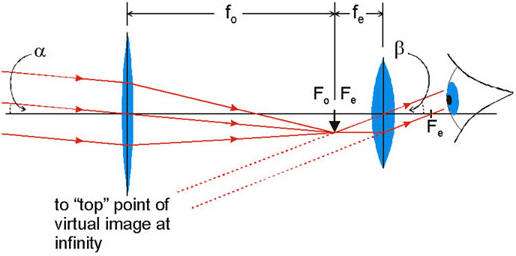
Aberrations
G.2.15 Explain the meaning of spherical aberrations and of chromatic aberration as produced by a single lens
You are expected to know of two types of optical aberrations, chromatic and spherical.
Chromatic aberrations are caused by the fact that different wavelengths of light are refracted different amounts by the glass in the lens which after all has a different density than air. This can be counteracted by using several lenses after each other that have different refractive indexes to effectively "bend the color back".
Spherical aberrations on the other hand are a result of that no lenses are perfectly spherical. Thus the light incident on the outer portions of the lens will be bent more than the light incident more in the center. To prevent this an aperture may be used to prevent light from hitting the outer portions of the lens.
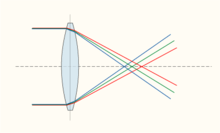
.png)
G.2.16 Describe how spherical aberration in a lens may be reduced
Spherical aberration in a lens may be reduced by:
- Shutting off the light near the edge of a lens (use an aperture).
- Grind the curvature.
- Use a combination of lenses. (eg. Use two lenses instead of one thicker one).
G.2.17 Describe how chromatic aberration in a lens may be reduced
Chromatic aberration in a lens may be reduced by:
- Using a combination of convex and concave lenses (a compound lens).
G3 Two-source interference of waves
G.3.1 State the conditions necessary to observe interference between two sources
In order for two light sources to create an observable interference pattern, the light from the two sources must be coherent.
G.3.3 Outline a double-slit experiment for light and draw the intensity distribution of the observed fringe pattern
Young's double slit experiment
G6 Thin-film interference
G.6.7 State the conditions for constructive and destructive interference
Conditions for constructive interference:
- The waves must have the same wavelength and the same frequency.
- The waves must be in phase
Conditions for destructive interference:
- The waves must have the same wavelength and the same frequency.
- The waves must be out of phase